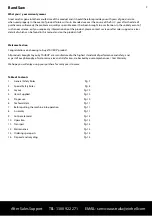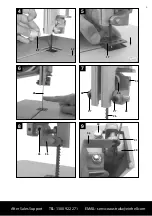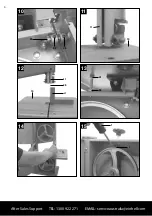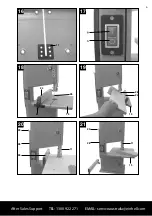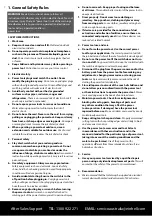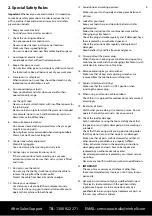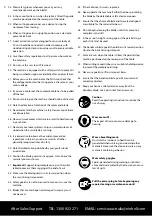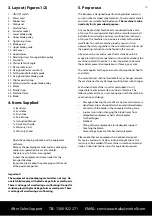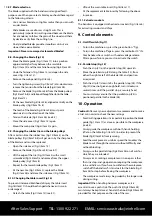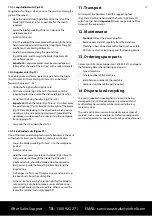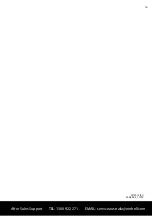
After Sales Support
TEL: 1300 922 271 EMAIL: [email protected]
13
8.7. Blade selection
The blade supplied with the bandsaw is designed for all-
purpose use. When you select a blade you should have regard
to the following criteria:
•
Use a narrow blade to cut tighter radius than you can with
a wider blade.
•
Wide blades are used to saw straight cuts. This is
particularly important in cutting wood because the blade
has a tendency to follow the grain of the wood and there
by deviate easily from the cutting line.
•
Finely toothed blades provide smoother cuts but are
slower than coarse blades.
Important: Never use warped or lacerated blades!
8.8. Changing the blade (Fig.14)
•
Move the blade guide (Fig. 1/Item 11) into a position
approximately half way between the saw table
(Fig.1/Item 15) and the machine housing (Fig.2/Item 25).
•
Undo the fasteners (Fig.1/Item 13) and open the side
cover (Fig. 1/Item 12).
•
Remove the web panel (Fig.3/Item 4).
•
Turn the tightening screw (Fig.1/Item 9) anti-clockwise to
remove the tension from the blade (Fig.2/Item 26).
•
Remove the blade (Fig.2/Item 26) from the blade pulleys
(Fig.1/Item 7 & 8) and take out through the slot in the table
(Fig.1/Item 15).
•
Fit the new blade (Fig.2/Item 26), aligned centrally on the
blade pulleys (Fig.1/Item 7 & 8).
•
The teeth of the blade (Fig.2/Item 26) must point
downwards in the direction of the table.
•
Tension the blade (Fig.2/Item 26) (see 8.2)
•
Close the side cover (Fig.1/Item 12) again.
•
Mount the web panel (Fig.3/Item 4) again.
8.9. Changing the rubber tires on the blade pulleys
After a certain time the rubber tires (Fig.15/Item 3) on the
blade pulleys (Fig.1/Item 7 & 8) will get worn by the sharp teeth
of the blades and must be replaced.
•
Open the side cover (Fig.1/Item 12).
•
Remove the blade (Fig.2/Item 26) (see 8.7).
•
Lift the edge of the tire (Fig.15/Item 3) with a small
screwdriver (Fig.15/Item f) and remove from the upper
blade pulley (Fig.1/Item 8).
•
Repeat for the lower blade pulley (Fig.1/Item 7).
•
Fit the new tire (Fig.15/Item 3), replace the blade
(Fig.2/Item 26) and close the side cover (Fig.1/Item12).
8.10. Changing the table insert (Fig.16)
To prevent increased likelihood of injury the table insert
(Fig.16/Item 17) should be changed whenever it is worn
or damaged.
•
Detach the table (Fig.1/Item 15) (see 8.1).
•
Lift out the worn table insert (Fig.16/Item 17).
•
Fit the replacement table insert by following the above
in reverse.
8.11. Extractor sockets
The bandsaw is equipped with extractor sockets (Fig.1/Item 6)
for extracting sawdust and chips.
9. Control elements
9.1. On/Off switch (Fig.17)
•
To turn the machine on, press the green button “l” (g).
•
To turn the machine off again, press the red button “0“ (h).
•
Your bandsaw has a switch with under voltage release.
After a power failure you must re-activate the switch.
9.2. Parallel stop (Fig.18)
•
Push the clip (21) on the parallel stop (24) upwards.
•
Move the parallel stop (24) along the table (15), from
either the right or left of the blade (26), and position
as required.
•
Push the clip (21) down to fix the parallel stop (24). If the
clip (21) does not give enough hold, turn it clockwise
several times until the parallel stop is securely fixed.
•
You must always ensure that the parallel stop (24) is
positioned parallel to the blade (26).
10. Operation
Caution!
After every new adjustment we recommend to make
a trial cut in order to check the new settings.
•
For all cutting operations it is important to position the blade
guide (Fig.1/Item 11) as close as possible to the workpiece
(see 8.5).
•
Always guide the workpiece with both hands, holding
it flat on the table (Fig.1/Item 15) in order to prevent the
blade (Fig.2/Item 26) from jamming.
•
Feed the workpiece at a uniform speed that enables the
blade to cut through the material without difficulty and
without blocking.
•
Always use the parallel stop (Fig.2/Item 26) on all cuts for
which they are intended.
•
Always aim at making a complete cut in one pass rather
than in a stop-and-go operation requiring the workpiece
to be withdrawn. If you have to withdraw the workpiece,
switch off the bandsaw first and wait for the blade (Fig.2/
Item 26) to stop before freeing the workpiece.
•
The workpiece must always be guided by the longer side
during cutting.
Important!
When handling narrower workpieces, it is
essential to use a push stick.The push stick (Fig.20/Item 28)
must always be kept close at hand at the hook (Fig.20/Item 29)
provided for that purpose on the side of the saw.


